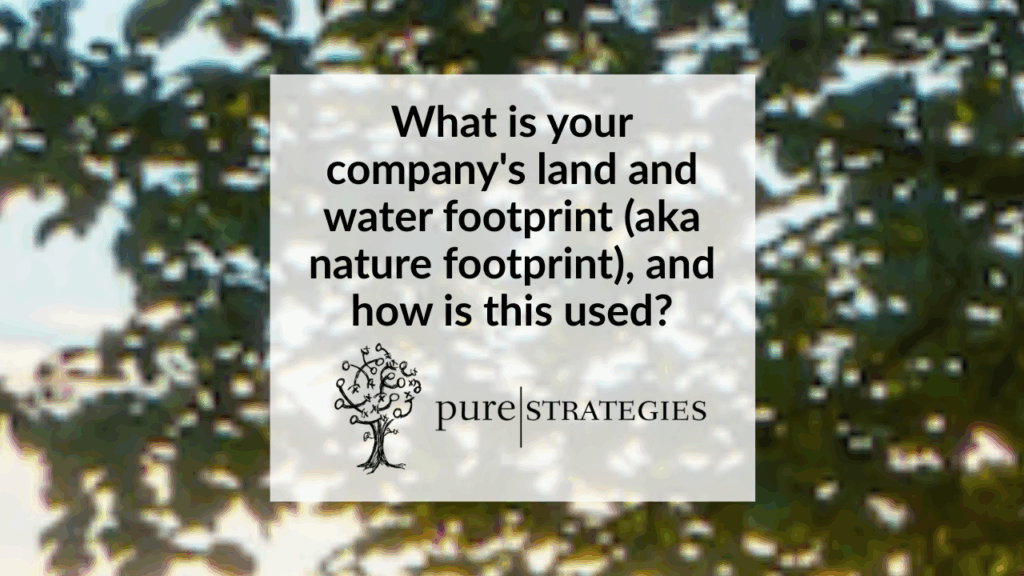Over two-thirds of populations of species have been lost since 1970. WWF is sounding the alarm, calling it a “code red” for the planet and humanity. To support progress, at the end of 2022, the global community formalized targets to conserve at least 30 percent of the world’s land, coastal areas, and oceans and restore 30 percent of terrestrial and marine ecosystems by 2030, along with additional targets, in the agreed Global Biodiversity Framework.
Businesses have a critical interest in meeting these global nature aims. All companies depend on natural resources, whether freshwater, crops, fiber or minerals, for their operations or supply chains. In fact, half of the world’s gross domestic product, or about $44 trillion, relies on nature.
Is a corporate climate target enough?
The warming of the climate threatens life on Earth. The IPCC’s latest science assessment released in March made it clear that “our world needs climate action on all fronts — everything, everywhere, all at once.” That means every company must step up its climate action as we rapidly approach 1.5 Celsius degrees of warming, the world’s target to prevent the worst effects of climate change.
Climate and nature are interconnected. For example, deforestation and forest degradation are notable and preventable sources of greenhouse gas emissions, responsible for around 15 percent of global emissions. Yet more than climate change, land use change is the largest threat to nature according to the WWF Living Planet Report. This means corporate efforts must extend sustainability beyond climate to address nature, ensuring that both are effectively and urgently addressed.
Corporate standards are encouraging this action. For example, the Science Based Targets initiative (SBTi) requires more than a climate target for businesses in the food, land and agriculture sector. A commitment to no deforestation is also needed.
What is a corporate nature strategy?
Businesses have an important role in supporting global nature aims. Only 17 percent of global land has been protected, yet the world agrees that we need 30 percent by 2030. The area that is best suited for protection and restoration, to yield the most benefits for nature and people, needs to be in strategic areas that are socially inclusive and “provide valuable ecosystem services, and they should be well-connected with corridors to improve resilience to climate change and avoid the creation of ecological islands.”
While governments will be critical in driving the necessary progress, company efforts are needed in parallel to avoid further nature destruction and biodiversity loss and to contribute to protection, restoration and regeneration. This is why the Global Biodiversity Framework included a target for businesses to monitor, assess and transparently disclose their risks, dependencies and impacts on biodiversity.
Where to start? A number of frameworks are being developed to help, but to simplify the steps, look to address the material impacts in at least these areas of your business:
- biobased materials
- extracted resources
- operational facilities
Looking a little deeper, Business for Nature and their partner’s framework for a nature strategy guides companies to Assess-Commit-Transform-Disclose. The first step to assess involves measuring, valuing and prioritizing the business’ impacts and dependencies on nature to ensure you address the most material issues on nature (such as biodiversity, freshwater, land, oceans and climate); commit entails setting transparent, time-bound, specific, science-based targets for nature to put your company on a path to operating within the Earth’s limits.
Transformation, or acting on your commitments, should follow a hierarchy that first avoids impacts, then reduces them, and last restores and regenerates degraded natural systems. Transform additionally includes collaborating with stakeholders across land and seascapes, shifting business strategy and models, and advocating for policy ambition.
Disclosure is about tracking your performance and publicly reporting material nature-related risks. The Taskforce on Nature-related Financial Disclosures (TNFD) is developing guidance to support this process from assessing your company’s nature-related risks and opportunities to a framework for disclosure.
Biobased materials broadly include agricultural crops, livestock, fiber, timber, pulp and seafood. These connect to multiple nature pressures such as land or marine use, overexploitation, pollution and invasive or alien species. Therefore, nature strategies for biobased materials often require several actions.
As an example, TAZO assessed its impact on the natural resources and communities in its raw material sourcing regions and committed to a net-zero emissions target and transitioning its entire tea portfolio to a regenerative and organic approach that gives back to soil health, the ecosystem and the people who rely on the land. TAZO is also working to ensure that by the end of 2023, its priority materials (tree fiber, sugar and tea) are sourced from supplies with no deforestation; it will protect, restore and sustainably manage more land, forests and oceans than needed by its business by 2026, along with having at least 80 percent of its ingredients by volume meet its regenerative agriculture standards by 2029.
Extracted resources such as minerals, metals and fossil fuels involve potentially highly damaging processes. Mining and drilling activities often pollute surface waters, soil and groundwater, erode soils and lead to biodiversity loss.
Holcim, a leader in the building industry with a range of products and services such as concrete and cement, has a nature strategy that covers climate, water and biodiversity priorities. For example, the company is committed to a measurable positive impact on biodiversity backed by the Biodiversity Indicator Reporting System by 2030. Supporting efforts include: 100 percent of active quarries have rehabilitation plans in place as of 2022, 100 percent of active quarries with high biodiversity value have specific Biodiversity Management Plans as of 2022, and 100 percent of active and non-active quarries will be measured using BIRS to establish its biodiversity baseline by 2024, up from 48 percent today.
Operational facilities include the land and buildings that the business owns, such as the impact of land development, manufacturing processes and waste generation on regional water systems and biodiversity.
As an example, Toyota Motor North America has partnered with the nonprofit Wildlife Habitat Council (WHC) since 1999 to restore habitats on its properties. Toyota has programs at 15 sites with voluntary Conservation Certification from WHC. At these sites, Toyota sets aside acreage, plants trees and pollinator gardens, installs and monitors bird nesting boxes and works with local schools to teach students about the importance of biodiversity.
In addition, TMNA is committed to support the development of at least 26,000 acres of pollinator habitat in North America by FY2026. This is implemented through a collaboration with Pollinator Partnership (P2) to reach high value areas in North America. TMNA also supports pollinator habitat on its own land and takes efforts to support native species and eradicate invasive species.
The code red call to action is clear. Companies need to help combat the dual crises of climate and nature. This includes setting and progressing on science-based targets for climate and addressing nature impacts, such as those from biobased materials, extracted resources and operational facilities. Getting a nature strategy in place alongside a climate program will help protect and restore biodiversity and vital ecosystems to support global nature aims and at the same time mitigate climate change and help with climate adaptation.
Transparency note: TAZO and Toyota Motor North America are clients of Pure Strategies.
This article originally appeared in GreenBiz on April 26, 2023.
Photo courtesy of Unsplash.


